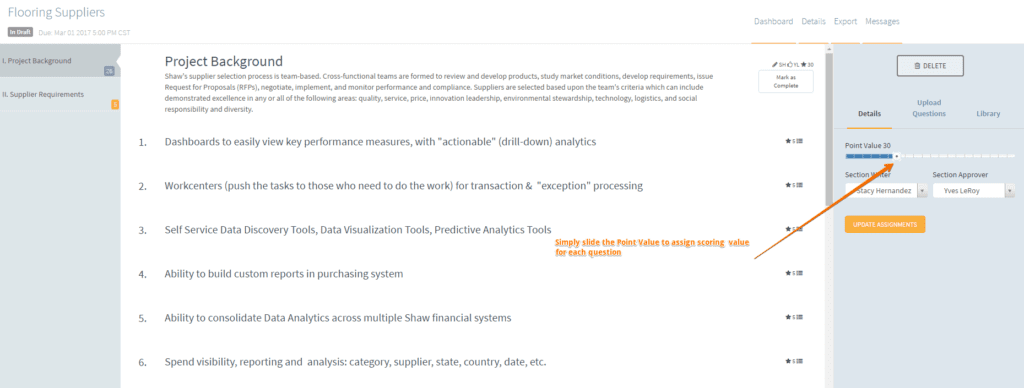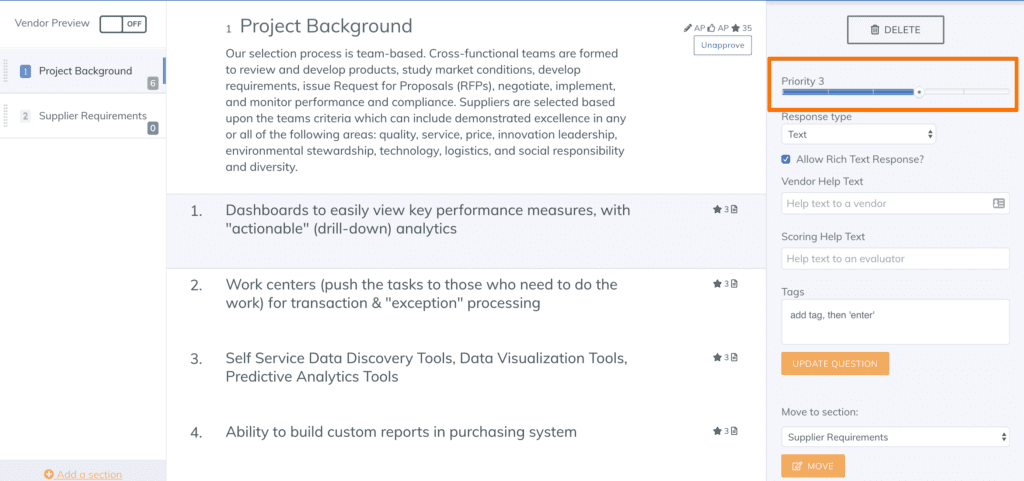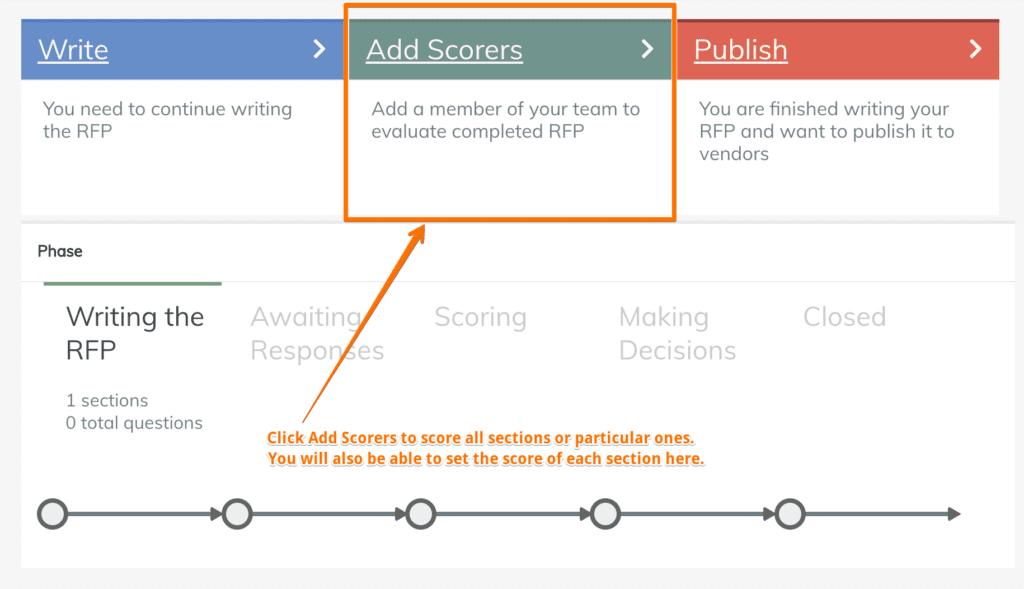RFP scoring isn’t high on most people’s list of favorite pastimes. It’s understandable, because the process is often complex and time consuming. However, when it comes to finding the right vendor and minimizing risk for your business, careful and accurate proposal scoring is crucial.
Making decisions based on RFP scoring data is one of the biggest advantages of using an RFP. Indeed, it transforms a subjective process into an objective one.
In this blog, we’ll explore RFP scoring. First, we’ll define the basics and primary approaches to RFP scoring. Then, we’ll explain how to navigate RFP scoring and set your business up for success with best practices. Finally, we’ll share examples and templates of common RFP scoring tools.
- RFP scoring basics
- What is RFP scoring?
- Proposal scoring approaches
- 3 steps to ensure effective RFP scoring
- Proposal scoring best practices
- Interpreting the results
- RFP scoring tools: Templates and examples
RFP scoring basics
What is RFP scoring?
Request for proposal (RFP) scoring, sometimes called proposal scoring, is the process of assigning numerical values to the RFP responses provided in a vendor’s proposal. As part of the proposal evaluation process, RFP scoring provides a data-based approach to support fair and unbiased vendor selection.
RFP scoring is particularly important in strategic sourcing which often involves questions that are open ended. Consequently, the resulting answers tend to be long and complex. Scoring provides a way to grade responses and compare prospective vendors at a glance. In addition, it allows evaluators to quickly identify a potential supplier’s strengths and weaknesses. Ultimately, successful RFP scoring and evaluation marks the conclusion of the RFP process.
Explore the RFP process in full. Download the ebook: The RFP process guide.
Proposal scoring approaches
There are two primary approaches to scoring proposals — simple scoring and weighted scoring. Both strategies have pros and cons.
Simple scoring
In this approach, each question is evaluated on a set scale, often from one to five. Evaluators assign the score based on the established scoring criteria.
Simple scoring example:
- Non compliant (Bad answer)
- Minimal compliance (Okay answer)
- Partial compliance (Acceptable answer)
- Mostly compliant (Good answer)
- Fully compliant (Perfect answer)
Pros: As the name suggests, simple scoring is fairly straightforward. For lower value, lower stakes projects or an RFP lite you can save time using simple scoring.
Cons: This scoring approach gives the same level of consideration to every question. For example, the question ‘Where is your company located?’ could earn the same number of points as ‘What are your key differentiators?’
RFP weighted scoring
The weighted scoring approach enables you to prioritize different elements of your RFP based on their importance to the business. For strategic sourcing RFPs, this scoring model enables a clearer picture of which vendor offers the best long-term value. Generally, weighted scoring is the preferred approach for most procurement professionals.
Pros: You can fully customize the value of each question and section of the RFP. Consequently, sharing this information with your vendors enables them to dedicate more time and attention to the areas of the RFP that are most important to you.
Cons: RFP weighted scoring is admittedly more complex than simple scoring. If done manually in spreadsheets, there is some risk of miscalculation. However, RFP management software automates this process, making it quick and easy.
To explore weighted scoring in more detail and see examples, visit the blog: Weighted scoring demystified.
3 steps to ensure effective RFP scoring
1. Set the stage during requirements discovery
Successful RFP scoring starts long before you issue an RFP or receive a single proposal. Indeed, much of the supplier selection process is determined during the requirements discovery phase of the RFP process. Ideally, your established requirements create the foundation for your RFP scorecard.
So, as you gather all your key stakeholders ask them to list the requirements that are most important. Your stakeholder group should include colleagues from different areas of the business. For example, it may be wise to engage the impacted department, finance, legal, operations and IT.
Prompt conversation with questions like:
- What’s our definition of success?
- How do we plan to achieve our goals?
- What specifications, features or functionality do we require?
- How should we categorize our RFP questions and requirements?
RFP category examples:
- Background – Company info and general info
- Functionality – Specifications, capabilities and features
- Pricing – Structure and options
- Implementation – Adoption process and timing
- Technical needs – Integrations and data security
- Reputation – Customer success and return on investment (ROI) figures
- Financial stability – History and future projections
- Security – Physical and data
2. Define your approach, priorities and scale
Approach
After you categorize your list of RFP requirements, you must determine the importance of each to decide which RFP scoring approach is best.
It’s uncommon, but if all factors are equally important, use simple scoring. If this is the case, you’ll use a standard scale — we recommend 1-5 as outlined above. Then, you can skip the rest of this step and begin writing RFP questions to gather the necessary data.
On the other hand, if your factors are of varying importance, you’ll need to rank them using weighted scoring.
Priorities
If you’re using RFP weighted scoring, ask stakeholders for input on the importance of each individual requirement and then each collective category. Start by designating factors as ‘must have,’ ‘nice to have,’ ‘not important,’ or ‘outside of scope.’
Then, assign the overall category with a weight. For example your category weights may include: functionality 40%, reputation 20%, financial stability 10%, technical requirements 10% and security 10%.
Scale and scoring rubric
While weighted scoring enables you to choose any scale you’d like, we still recommend a 1-5 scale for ease of use. The scale can be used for all question formats: yes/no, true/false, multiple choice and open-ended.
Now, write the RFP questions to uncover the information you need to make a decision. As you do, determine how to score the question. For either/or questions, assign maximum points for your preferred response and the lowest value for the alternate. Do the same for multiple choice questions, assigning middle values as needed.
For open-ended questions, identify several potential answers for your most important questions. These example answers should cover your ideal response, an acceptable response and an unacceptable response. You’ll use these sample responses to build a scoring rubric.
3. Provide clear direction for evaluators
Whether you have two evaluators or 10, they each bring their own unique perspective and experiences to proposal scoring. The variety of views is both an advantage and a potential roadblock to reaching a clear decision.
Having multiple scorers reduces the risk of missing important considerations. On the other hand, each scorer may interpret questions and answers differently. Consequently, it’s up to the procurement manager to provide helpful guidance.
Using the sample responses you created in the previous step, build a scoring matrix or rubric. Offering specific examples of ideal answers helps ensure everyone is on the same page. In addition, ensure scorers that if a noticeable discrepancy arises, you’ll step in to help clarify and navigate the issue.
Proposal scoring best practices
To get accurate and reliable results, it’s important to follow RFP scoring best practices.
Write scoring criteria before RFP questions
It’s important to know what you need before you begin writing questions. Indeed, this practice ensures your questions are relevant, concise and focused.
Keep it brief
It may sound obvious, but one of the best ways to keep the vendor scorecard simple is to create a shortlist of invited vendors. We prefer capping our RFPs at about five vendors and asking 20 questions or less. It doesn’t sound like much, but it still means each evaluator has to judge and weigh 100 individual responses.
Engage the right stakeholders
As mentioned above, it’s important to ask stakeholders to participate both in requirements gathering as well as scoring. However, carefully consider each participant because the larger the group, the more time will be required. When it’s time to score proposals, assign evaluators to the sections and questions relevant to their expertise, rather than having them score the entire response.
Implement blind scoring
Blind RFP scoring is the practice of removing vendor information from proposals. This reduces the risk of an unintentional bias swaying the RFP results and subsequent supplier selection. It is particularly important if there’s an incumbent or preferred vendor prior to issuing the RFP.
Publish your scoring approach in the RFP
While some buyers hesitate to share the details of their RFP scoring process with vendors, we don’t see the down side. After all, the more a supplier knows about your needs, the more they can customize their response. For instance, if integrations are only worth five percent of the total score, the vendor can provide simple answers rather than paragraphs of detail.
Leverage the latest RFP technology
Everyone agrees raw data isn’t helpful if you can’t effectively interpret it, and RFPs are no different. So, if you want to make things really easy, think about investing in RFP software.
Not sure you want to pay for specialized RFP software? Consider this big advantage: You don’t have to compile manual spreadsheets. That means no complicated weighted-decision template matrix, macros, complex formulas or miscalculations.
For example, RFP360 offers built-in algorithms that make it easy to score individual questions (not just sections). This results in a more indicative overall score, giving you a shorter evaluation time, fewer opportunities for human error and clearer vendor comparisons.
Interpreting the results
Once you get an RFP score, do you have to choose the supplier with the highest score? The short answer is no.
According to procurement veteran Phil Ideson of Art of Procurement:
“Recognize that the supplier that you end up selecting may not be the one that scores the best on the weighted scoring algorithm. Because there are things that are a bit more subjective that do play a big role in selecting your final supplier … When you’re looking at commoditized products and services there has to be a reason why you’re not selecting the highest scored supplier. I’d suggest that if there is a good reason you don’t choose them, in that instance, your weighting was flawed.”
Simply put, there will be times when you don’t select the highest-scored candidate. But, you may also want to revisit your selection criteria. We can relate.
When the highest score isn’t the right choice
A couple of years ago when we issued an RFP for a public relations consultant, we actually chose the second-highest-scored provider. Why? We couldn’t swallow the price tag of the top candidate. So, we chose the second-tiered supplier because the difference in points wasn’t high enough to overcome the price discrepancy.
Choose the highest-scored provider when:
- The highest score meets the key decision-makers’ exact selection criteria
- Your team has thoughtfully prepared and agreed upon your scoring criteria
Think twice about choosing the highest-scored provider when:
- It’s a commodity purchase, and the only true consideration is price
- Your incumbent was second in line, but your successful history with them tips the scale
- It was difficult to score the project — it was too high level or open ended
Of course, as with all RFP best practices and guidelines, take it with a grain of salt. Each industry, organization, and RFP is unique.
RFP scoring tools: Examples and templates
For a more in-depth look at how to create an effective RFP scorecard, let’s break down a few examples and templates
Vendor scorecard template: Smartsheet
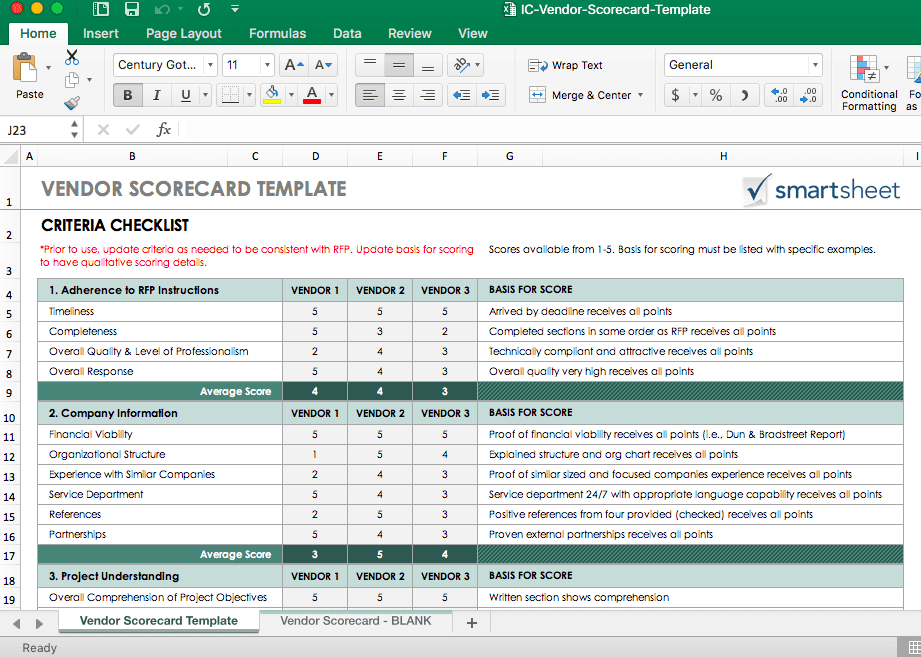
This vendor scorecard template from Smartsheet evaluates vendors based on eight criteria:
- Adherence to RFP Instructions
- Company Information
- Project Understanding
- Requirements
- Product Viability & History
- Terms & Conditions
- Vendor Demonstration
- Fee Summary
It includes one tab that demonstrates how the scorecard should look once completed, as well as a separate blank tab you can use to evaluate your potential vendors.
RFP evaluation scoring sheet: Minnesota Department of Transportation
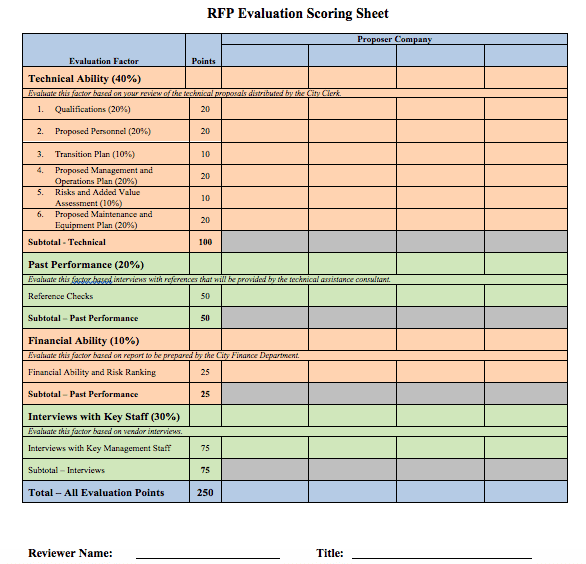
The Minnesota Department of Transportation’s RFP evaluation scoring sheet is designed to ensure they select contract operators “based on a competitively negotiated method of procurement.”
RFP evaluation scorecard: University of Wisconsin-Madison, Division of Business Services
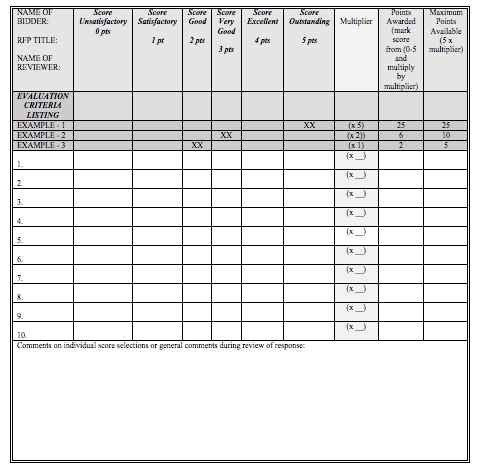
The University of Wisconsin-Madison, Division of Business Services, created this RFP evaluation scorecard. They offer the following instructions for use:
“Before giving to reviewers the Procurement Team Leader should enter each evaluation criteria to be scored in first column and indicate the priority level under the ‘multiplier’ column. The evaluation criteria with the highest priority will have the highest multiplier, e.g., ‘x 10’ and the lowest priority criteria will have the lowest multiplier, e.g., ‘x 1’. Multiply the multiplier by ‘5’ to obtain the highest number of points for each criteria (since ‘5’ is the highest score).
“Reviewers must check one score (0-5) for each criteria. Multiplying the marked score by the multiplier will result in the total points awarded for that criterion.”
Vendor scorecard: MediaPro
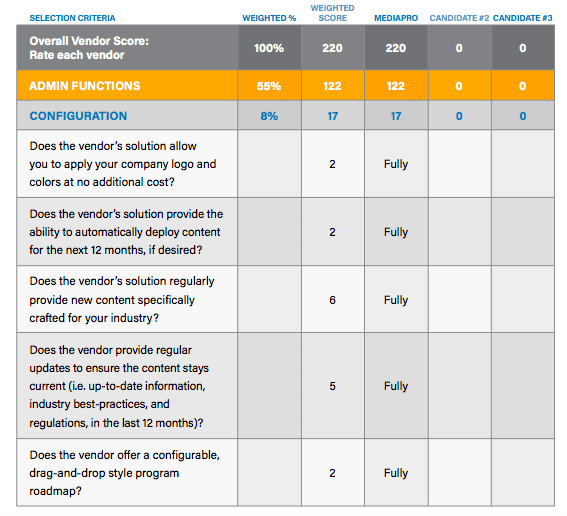
MediaPro created this vendor selection scorecard to “help security and privacy program administrators who are developing new employee awareness initiatives or want to enhance existing ones to help their organizations address the risks that employees pose to their company.”
They go on to explain that the scorecard “assists in rating, analyzing, and comparing core features and functionalities offered by potential awareness program vendors as they make an informed selection.”
Just as RFPs are a tool to help you collect information from vendors, RFP scoring is the way you quantify and evaluate that information. Using a thoughtful and consistent scoring strategy improves process efficiency and reduces the risk of selecting the wrong vendor — making it an essential part of any effective RFP process.
Originally published May 20, 2019 — Updated August 19, 2021

